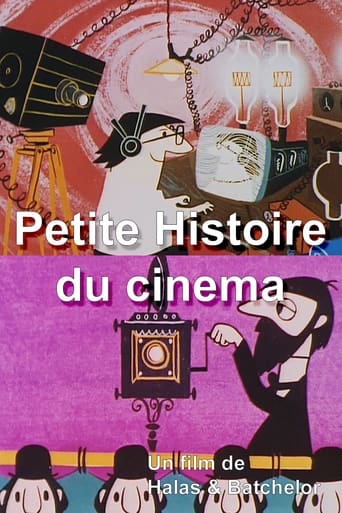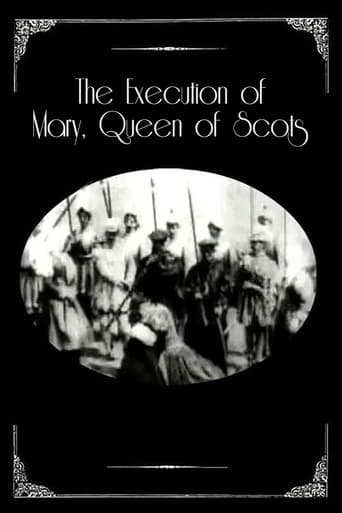


The Execution of Mary, Queen of Scots
A short film depicting the execution of Mary, Queen of the Scots. Mary is brought to the execution block and made to kneel down with her neck over it. The executioner lifts his axe ready to bring it down. After that frame Mary has been replaced by a dummy. The axe comes down and severs the head of the dummy from the body. The executioner picks up the head and shows it around for everyone else to see. One of the first camera tricks to be used in a movie.
-
- Cast:


Similar titles
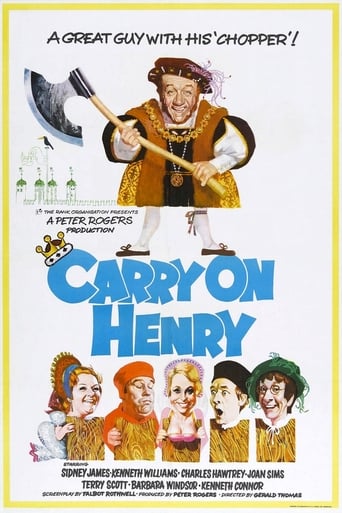
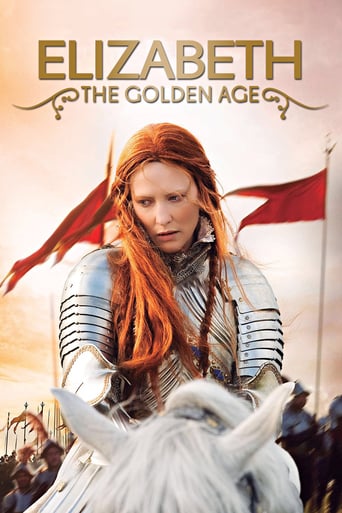
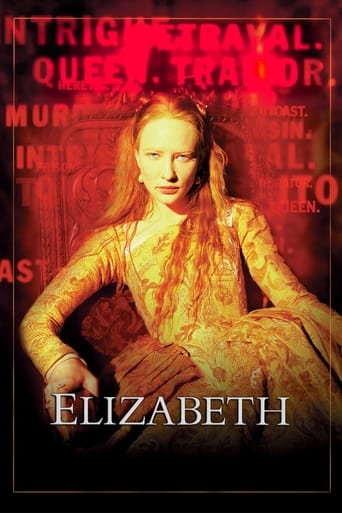
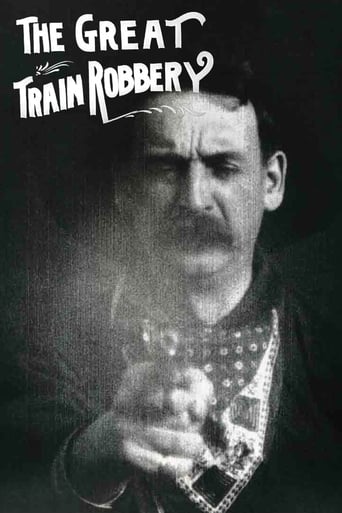
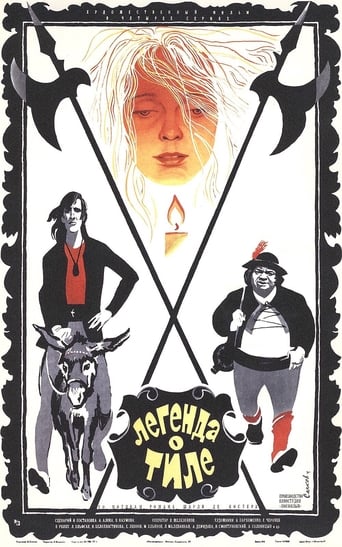
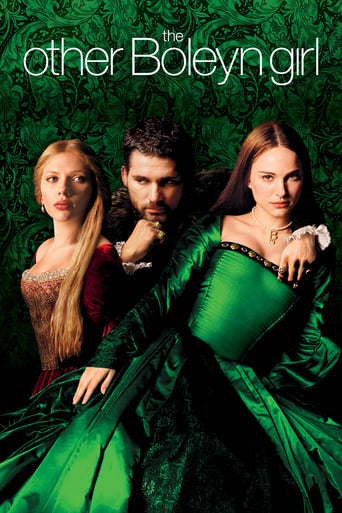
Reviews
This Movie Can Only Be Described With One Word.
This is How Movies Should Be Made
The plot isn't so bad, but the pace of storytelling is too slow which makes people bored. Certain moments are so obvious and unnecessary for the main plot. I would've fast-forwarded those moments if it was an online streaming. The ending looks like implying a sequel, not sure if this movie will get one
One of the film's great tricks is that, for a time, you think it will go down a rabbit hole of unrealistic glorification.
Execution of Mary, Queen of Scots, The (1895) *** 1/2 (out of 4)This Edison short was one of the first movies to deal with a real event and the payoff is actually very good. Mary Stuart is taken to the chopping block where she puts her head down and has it hacked off. The special effects in the film are very well done but I'm not sure if the edit is done in a good fashion or if we just can't see it because the print quality is so shaky. Either way this is nicely done and shows that there were some violent films being made back in the day. I've read that this film was pulled from various places because people actually believed that the woman gave her life for the movie. You can't help but think what these folks would feel about certain violent movies of today.
This film seems to be the first edited film. It is a historical reenactment of the 8 February 1587 execution for treason of the deposed monarch. In it, Mary kneels before the executioner, and once he raised his axe, the filmmakers (Alfred Clark and William Heise) stopped filming. (Interestingly, Mary is portrayed by a man--a relic dating back to Elizabethan and Shakespearian times when women were barred from the stage. This is even odder because the Edison Company had since introduced female stage performers to the movies.) They replaced Mary with a dummy and resumed filming--creating a jump cut. The executioner promptly beheads her. In post-production, the filmmakers spliced the shots together to create a seamless, that is, invisible transition; at least, that was their hopeful intention.Today, the splice is quite noticeable (although maybe not if you're viewing an Internet transfer) if you look for it (in the lower half of the frame), as are the differences in proportion and position of the actor and the dummy. Given the technical limitations of 1895, however, it's effective. Méliès and many others did the same thing for years afterwards, including most popularly in the trick films. In "The Great Train Robbery", released eight years later, the replacement of an actor with a dummy is more obvious than here, and it is so with many other later films, so the filmmakers here did well. The splice probably wasn't too noticeable when viewed through the Kinetoscope peephole viewer, as originally intended, either.This must have been quite an effective film for its time, but the apocryphal stories are dubious. One of them, told at this web page's trivia, is that spectators believed a real murder was committed for the camera. Another is that some fainted during viewings. There are many anecdotes like this for various early films, but they're generally not this far fetched. I haven't read any credible evidence or support for these two particular stories, either.The introduction of editing is of immense historical importance to film. It is exclusive to this medium--distinguishing it further as a unique art and opening not only opportunities for temporal reordering, but also (in later movies) for further spatial dimensions. Without it, the story film--cinematic narrative--is hopeless. It took a while for filmmakers to realize this, though. After this film, the Edison Company went back to filming single shot pictures. The earliest films with spatially separate scenes didn't begin appearing until about 1898, which not coincidently, coincides with the adoption in cameras and projectors of the Latham Loop: a device that relieves tension and vibration from the moving filmstrip that otherwise might tear it, thus allowing for longer and edited films. Economics was also a major factor in the sluggish advancement in multi-shot films, as exhibitors, and not producers, largely controlled the final appearance of film back then--supporting the single-shot film for longer than technical limitations demanded.In addition to production and post-production innovations, the filmmakers here also gave care to pre-production matters. According to Gordon Hendricks, and contrary to Charles Musser (both authorities on the subject), this film was shot in the environs of West Orange, rather than on the lot of the Edison Laboratory. Although the Kinetograph camera was bulky, the Edison Company had filmed several subjects outside before. Hendricks, however, suspects that this film was photographed with a new, more portable camera. The novelty here, however, is its attempt at dramatic realism that is its historical reenactment (perhaps the earliest such film). Thus, also for possibly the first time, this film features professional, theatrical actors. Additionally, as evidenced by an extant document (provided by Hendricks in "The Kinetoscope"), Clark was involved in the precise costume decisions and devised cautious planning for weather conditions. Although these innovations in the production of a reenactment aren't as cinematically innovative as editing and are, really, rather theatrical, they nonetheless were also important steps towards the development of film narrative and the increasingly elaborate nature of film production.Today, this film seems inadequate; without its title and producers' descriptions, who would know that's it's a historical reenactment; that could be the beheading of anyone. There's also the lack of blood. As to historical accounts, it's not as interesting as other stories, which include two or three chops of the axe--perhaps, intentional, and, perhaps, clumsy. When the executioner holds up her head, there's no wig. This is a clean and simple execution. Additionally, the edit is a jump cut intended to be invisible in joining together two scenes that are spatially the same. Yet, it wouldn't be until about 1898 that action across spatially separate scenes emerged. It would be the Edison Company, however, that probably introduced multiple perspectives, with such films as "Return of Lifeboat" (1897).The two filmmakers of "The Execution", though, deserve mentioning in the history books. The innovations of this film seem to have been mostly the work of its director Alfred Clark. He had just transferred from Raff & Gammon (the financiers of many Edison Company films), where he had been working in the phonograph business--another Edison invention. In a short span, Clark made several historical films, including "Joan of Arc" (1895) on the same day. Predictably, that film is about the saint's execution by burning. He would make few others before returning to the phonograph business.William Heise co-invented the Kinetograph and Kinetoscope and thus motion pictures. With William K.L. Dickson, who had recently left Edison for Biograph and cinema, they made some of the earliest films ever made. Heise's name is behind many firsts in film.(Note: This is the fourth in a series of my comments on 10 "firsts" in film history. The other films covered are Traffic Crossing Leeds Bridge (1888), Annabelle Serpentine Dance (1895), La Sortie des usines Lumière (1895), L' Arroseur arose (1895), L'Arrivée d'un train à La Ciotat (1896), Panorama du Grand Canal vu d'un bateau (1896), Return of Lifeboat (1897) and Panorama of Eiffel Tower (1900).)
For the technicals, I am sure they could'nt have done better for 1895, but this is quite pathetic... I can easily see the camera moving a little when the actor is replaced. I expected something horrorish but it was'nt at all! The 'video' does also not really appeal to the reality happening. I would not expect a woman to be so easy during the beheading scene, since it would be that she would fight for her life and struggle or at least cry during the process. None of this is to see. You also see the head moving when the actor gets replaced by the dummy of which you can then easily see the fakeness. This was like an experiment of trying to make an early ghost picture.
This film is totally lacking any drama and pacing. How anyone could bring themselves to sit through such badly directed and wooden performances is simply beyond me.

